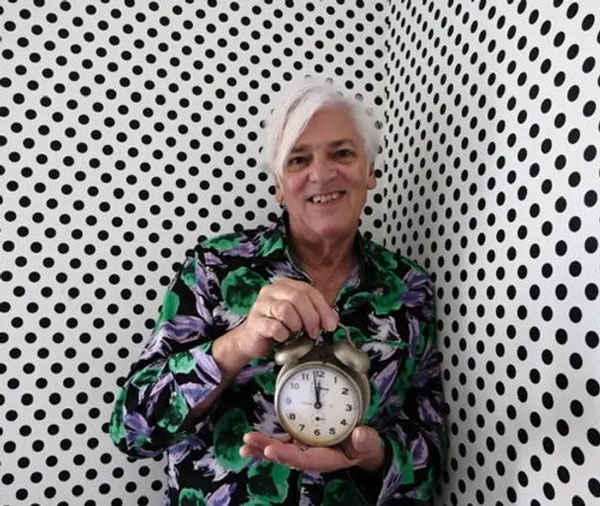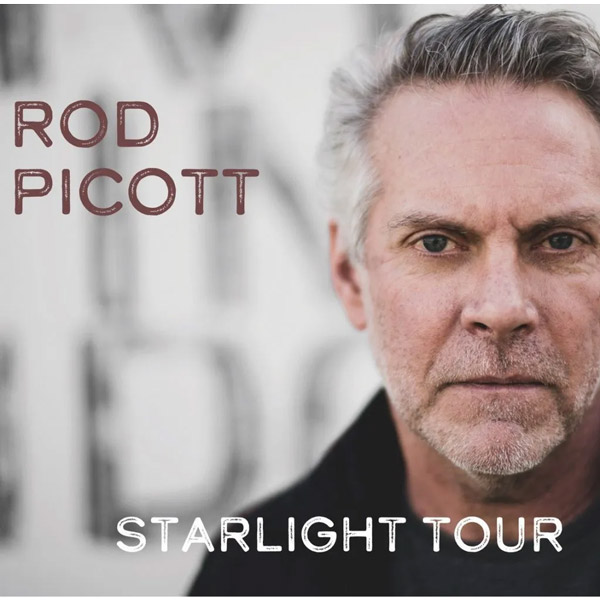Pat Metheny's "Dream Box Tour" LIVE! at MPAC
By Spotlight Central, Photos by Love Imagery
originally published: 04/15/2024
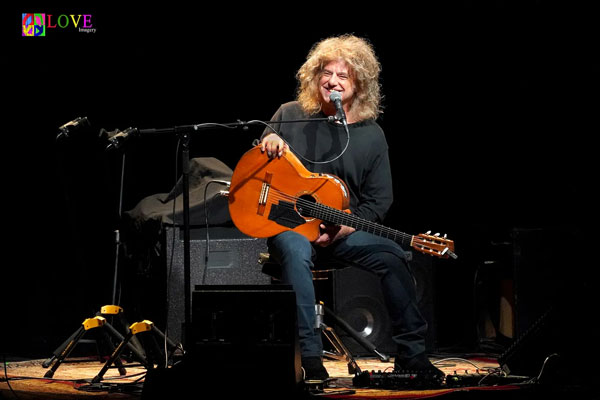
Despite the earthquake that rocked the Northeastern United States this April 5, 2024 morning and the aftershock which shook Morristown, NJ in the early evening, music lovers are ready and waiting inside Morristown’s MPAC auditorium for a solo Dream Box Tour concert by musician Pat Metheny.
Metheny, 69, is a Grammy-winning guitar prodigy. Not only is he a virtuoso on the traditional jazz guitar, but he also plays a nylon-stringed classical-style model, a 6-string baritone guitar, an 8-string steel guitar, a 42-string Pikasso guitar, a guitar synthesizer, and an electric guitar controller which drives an “orchestrion,” a collection of musical instruments which can be sequenced or played based on computerized instructions.
Inside the auditorium, concertgoer Nancy from Morristown reveals, “I’ve been listening to Pat Metheny since the 1970s. To me, he sounds like he’s a different artist all the time because his music is just so broad and everything he does is just so different, so I’m really looking forward to seeing him perform tonight.”
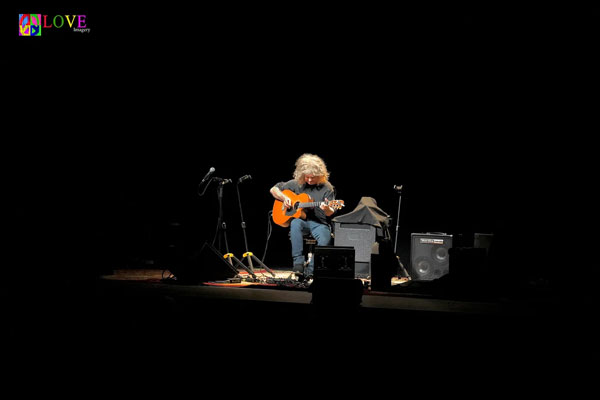
Nancy’s friend, Kathy from Morristown, agrees, noting, “I’ve listened to Pat Metheny for a long time. I’ve heard his music on Sirius radio and noticed that much of it is acoustic. That’s something he does that I like a lot, so I’m especially looking forward to hearing what he plays tonight.”
Likewise, Barry from Morris Plains recalls, “I go back a long way with Pat Metheny. The first time I saw him was back in 1979 in Philly with the Pat Metheny Group featuring Lyle Mays, and I’ve even met him twice. Since I haven’t seen him in a few years, I wanted to come out tonight, not only because it’s very vast what he can do as a musician but, also, because tonight will be the first time I’ll get to see him perform in a solo setting.”
The crowd cheers as Pat Metheny takes the stage smiling. Picking up his nylon string acoustic guitar, he opens tonight’s show with a medley of original songs.
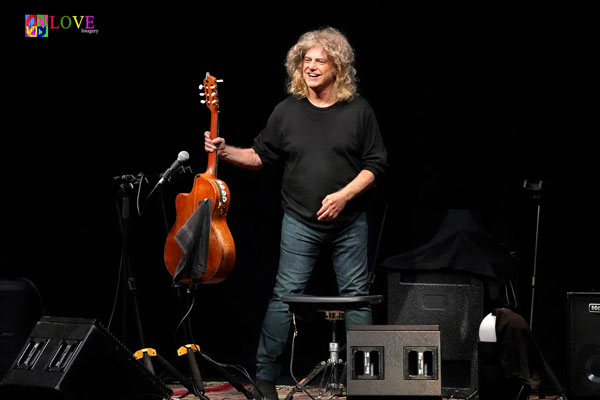
On the medley, which includes tunes like “Phase Dance” and “Minuano (Six Eight),” Metheny makes his guitar sing. Playing with intention with his head down, his music swells and surrounds the audience with a wave of warmth. Weaving in and out of his various compositions with skillful fingering and fingerpicking, Metheny varies the music in terms of tempi and dynamics before arriving at the potpourri’s rubato ending as lights fade.
The crowd avidly applauds and Metheny welcomes the audience saying, “Thanks so much, it’s great to be back in this fantastic theater,” explaining, “Everything tonight will revolve around the guitar.”
After revealing that, as a youngster, he initially started out in music as a trumpet player, Metheny talks about seeing The Beatles on television and asking his parents to allow him to buy a guitar with his own money. Getting turned on to jazz after listening to Miles Davis’ 1968 album, Four and More, by the age of 14, Metheny began playing on bandstands in Kansas City before going on to work with such nationally known jazz artists as Gary Burton, Keith Jarrett, and Charlie Hayden.
Suggesting, “Tonight, there will times when I will play very soft,” Metheny jokingly requests, “If you cough during those sections, please do it in a musical way — but at other times, you can cough right out loud.”
Metheny sails into a medley of songs from his 1997 recording with Charlie Haden, Beyond the Missouri Sky. Playing softly and sweetly on his nylon string acoustic, Metheny fingerpicks through a patchwork of melodies prior to shifting into a Latin Bossa nova feel where each turn of phrase captures the audience’s attention.
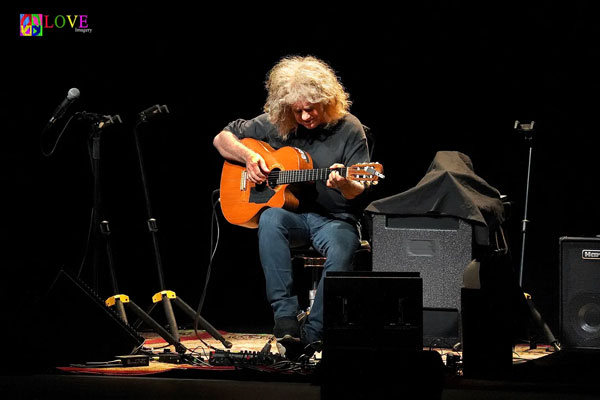
Following a number played on a six-string acoustic guitar where Metheny alternates picking and strumming while using a foot pedal to modulate the sound, he impresses by creating an avant-garde sound painting on his eight-string guitar. Bending and sliding on the strings, Metheny generates a cacophony of sound, making animal-like noises before producing a symphony of clashes in which he doubles the effect by looping his own performance. Building in intensity and dissonance, Metheny makes speed and sound meet in space, prior to ending with the lights darkening and the MPAC crowd reacting with delight.
Next up is a number which features Metheny playing his 42-string Pikasso guitar. On this improvisatory piece, Metheny strums part of the guitar like a harp and also taps on the body of the instrument for effect. Strumming on the instrument’s upper strings with his right hand, he creates a bass line by simultaneously fingering the lower neck with his left hand without plucking any of those strings at all. Near the end of the piece, Metheny gently rubs the strings, caressing the song to its conclusion as an audience member shouts “Bravo!” and the rest of the crowd reacts with enthusiastic cheers and applause.
Joking, “What’s the deal with that guitar?” Metheny talks about its builder, Linda Manzer, revealing he once asked, “How many strings can you put on a guitar before it explodes?” prior to receiving the definitive answer: “42!”
Metheny also talks about his history with the baritone guitar — a larger and deeper-sounding variant of the traditional guitar — recalling that he once recorded himself playing one for six hours with the two middle strings tuned up an octave and released the recording as his 2003 album, One Quiet Night. He also reveals that he often enjoys playing popular songs he knows and loves prior to launching into a medley of pop tunes from his 2011 album, What’s It All About.
Starting off with Burt Bacharach’s “Alfie,” Metheny’s brilliant solo guitar playing sounds like a full band before he segues into Paul Williams’ hit for The Carpenters, “Rainy Days and Mondays,” where the timbre shifts to low and almost mournful. The sad, resonant sound continues into Carly Simon’s “That’s the Way I’ve Always Heard It Should Be” where Metheny renders the melody with feeling and style prior to morphing into an interpretation of Antônio Carlos Jobim’s “Girl from Ipanema” which features Metheny playing a slow Latin feel complete with dissonance.
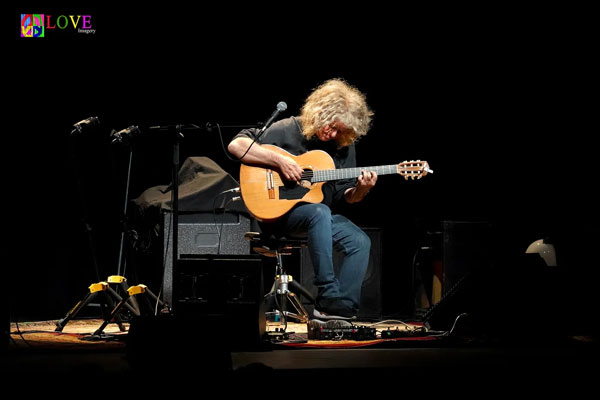
The crowd hoots and hollers as Metheny wraps up his pop song medley with a final number before asking, “Did anyone recognize any of those tunes?” and explaining that he included the last song because so many people request that he play his own composition, “Last Train Home.”
In illustrating the difference between a baritone guitar and a standard guitar, Metheny likens the tuning of the baritone to the instruments found in a string quartet when he explains, “The top two strings are the viola, the bottom two are the cello, and the middle two are the violins.” He also talks about his idea of utilizing nylon strings on a baritone guitar — something he was only recently able to accomplish — and plays an example where the low timbres of the instrument resonate as the higher strings dance.
Metheny follows up with a pair of songs played on the baritone guitar including a sweet and moving arrangement of The Beatles’ “Here, There and Everywhere” and a beautiful and a tender interpretation of “Danny Boy.”
Metheny switches over to a hollow body jazz guitar for the jazz standard, “Black Orpheus,” on which he loops in a bass line and, then, picks quickly and rhythmically over the bass line adding live melody and chords prior to ending the performance to large applause.
Metheny’s looping technique is also featured prominently on the next several pieces which include a swing blues number where he adds drone tones to create tension and interest, a ballad where he solos over his recorded bass line with style and a gentle touch, and a high-energy jazz fusion piece where Metheny stands as he bends his strings and picks out a solo with rhythmic breaks before the crowd erupts in applause while Pat wipes his brow.
A highlight of tonight’s show occurs after the curtain behind Metheny opens to reveal a portable version of his “orchestrion” in the form of a unique set of real-life percussion instruments which Metheny can sequence or play with his guitar controller. As Metheny deftly solos on his hollow body jazz guitar, the orchestrion whirrs with blinking lights, the tinkling rhythmic cacophony of sound including finger cymbals, bells, and glockenspiels accompanying Metheny on his musical journey.
As the sound piece evolves, Metheny removes a cover from a guitar on a stand stage left and begins to play and record it. Soon, Metheny reveals another guitar stage right that he strums and caresses, adding another layer of sound to his symphony that sets toes tapping and heads bobbing. Finally, Metheny adds the wailing sound of his guitar synthesizer to the mix as lights cascade behind him. At the conclusion of this heady concoction, concertgoers stand and cheer as Metheny takes a bow and exits.
For an encore, Metheny retakes the stage picking a steel string acoustic guitar. After recording himself playing that instrument, he loops in his hollow bodied jazz guitar and then adds in the kaleidoscopic percussion sounds of the orchestrion as the piece streaks along its musical pathway. When the crowd avidly cheers at the end, Metheny bows with a smile and points to all the instruments on the stage as if they were performers, too.
For a second encore, Metheny gives the MPAC audience the gift of a beautiful, sweet, and clear acoustic guitar rendition of Jimmy Webb’s “Wichita Lineman.”
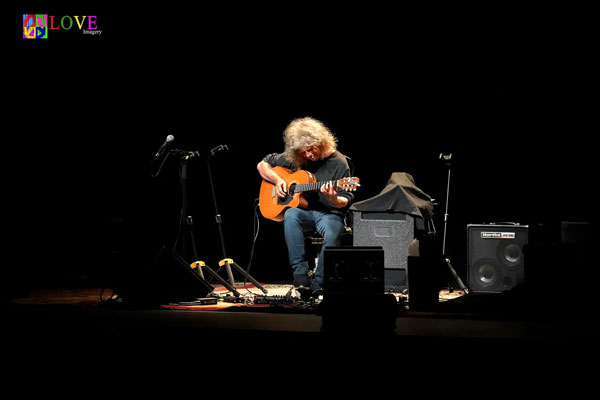
Ending with the angelic sound of harmonics which elicit heartfelt cheers, Metheny modestly replies, “Thank you.”
As concertgoers exit the MPAC auditorium, several comment on Pat Metheny’s performance this evening. Remarks Ken from New Providence, “I thought it was a great show. It’s the first time I’ve seen Pat Metheny play solo and he was impressive,” prior to joking, “I mean, how many guitars did he play, 15?”
Ken’s daughter, Georgia from Jersey City, acknowledges, “I’d never seen Pat Metheny before, and I loved this concert. It was my Christmas present to my dad and I absolutely enjoyed it. Pat Metheny is such a versatile musician, and I especially loved the reveal of the wall of percussion at the end with the orchestrion — it was amazing!”
Lastly, Charles from Los Angeles declares, “This show was brilliant! I’ve listened to Pat Metheny’s music my whole life and this is the first time I’ve ever seen him in person,” adding, “I didn’t know how he could ever do what he’s able to do until I saw it for myself live,” prior to concluding, “He’s got a gift that no one else has.”
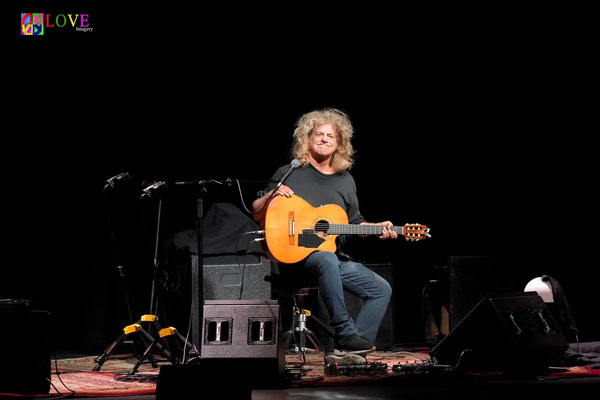
To learn more about Pat Metheny, please go to patmetheny.com. For info on future MPAC concerts — including Kansas on April 26, Buddy Guy’s Damn Right Farewell Tour on May 3, and Dweezil Zappa’s Rox(postroph)y Tour on August 22 — please click on mayoarts.org.
Photos by Love ImagerySpotlight Central. Your source for Jersey entertainment news and reviews
Love Imagery Fine Art Photography. all you need. peace/love/flower/power
FEATURED EVENTS
Narrow results by date, categories, or region of New Jersey.

Trombone Shorty & Orleans Avenue
Thursday, November 21, 2024 @ 7:30pm
State Theatre New Jersey
15 Livingston Avenue, New Brunswick, NJ 08901
category: music
View event page for full information

Randall Goosby Returns: Renaissance Quartet
Thursday, November 21, 2024 @ 7:30pm
McCarter Theatre Center (Matthews Theater)
91 University Place, Princeton, NJ 08540
category: music
View event page for full information

Marshall Crenshaw - Up Close & Personal
Thursday, November 21, 2024 @ 7:30pm
Lizzie Rose Music Room
217 E. Main Street, Tuckerton, NJ 08087
category: music
View event page for full information
More events
Event Listings are available for $10 and included with our banner ad packages
EVENT PREVIEWS

Renaissance Quartet Brings Bold Innovation and Classical Mastery to McCarter Theatre on Thursday
(PRINCETON, NJ) -- Prepare to be captivated by the Renaissance Quartet, featuring violinists Randall Goosby and Jeremiah Blacklow, violist Jameel Martin, and cellist Daniel Hass. Graduates of the Juilliard School and mentored by the legendary Itzhak Perlman, the Quartet brings a unique blend of classical mastery and innovative flair to McCarter Theatre on Thursday, November 21, 2024 at 7:30pm. Known for reimagining chamber music traditions, this New York based ensemble combines technical excellence with a bold, forward-thinking approach that appeals to a diverse audience.
UPCOMING EVENTS
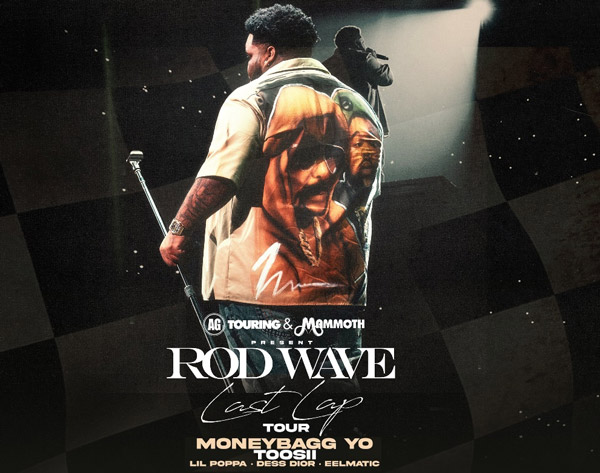
Rod Wave - Last Lap Tour comes to Prudential Center in December
(NEWARK, NJ) -- This Fall, AG Touring and Mammoth, Inc. proudly present the Rod Wave - Last Lap Tour. This large-scale multi-city outing will feature Rod Wave headlining 36 of North America's top arenas coast-to-coast. The tour will kick off on October 19 at Desert Diamond Arena in Phoenix, AZ visiting major markets across the country, including Newark’s Prudential Center on Tuesday, December 3, 2024 with special guests Moneybagg Yo, Toosii, Lil Poppa, Dess Dior and Eelmatic.















